
The Bhimbetka rock shelters are an archaeological site in central India that spans the prehistoric Paleolithic and Mesolithic periods, as well as the historic period. It exhibits the earliest traces of human life in India and evidence of Stone Age starting at the site in Acheulian times. It is located in the Raisen District in the Indian state of Madhya Pradesh about 45 kilometres (28 mi) south-east of Bhopal. It is a UNESCO World Heritage Site that consists of seven hills and over 750 rock shelters distributed over 10 km (6.2 mi). At least some of the shelters were inhabited more than 100,000 years ago. The rock shelters and caves provide evidence of, according to Encyclopædia Britannica, a "rare glimpse" into human settlement and cultural evolution from hunter-gatherers, to agriculture, and expressions of prehistoric spirituality.

Devi Jagadambika Temple or Jagadambika Temple is one of a group of about 25 temples at Khajuraho, Madhya Pradesh, India. Khajuraho is a World Heritage Site. The temples of Khajuraho were built by the rulers of the Chandela dynasty between the 10th and the 12th centuries.
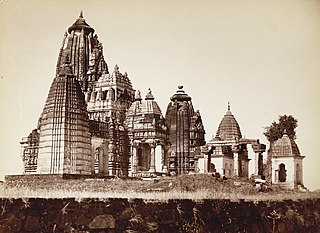
The Jain temples of Khajuraho are a part of the UNESCO World Heritage Site of Khajuraho. They are located in Chhatarpur district, Madhya Pradesh, India, about 175 kilometres southeast of the city of Jhansi.

The Varaha Temple at Khajuraho enshrines a colossal monolithic image of Varaha, the boar incarnation of Lord Vishnu. This temple depicts Varaha as a purely animal form. The temple is located in the Western Group of Temple Complex Khajuraho Group of Monuments, a World Heritage Site inscribed by UNESCO in 1986 in Khajuraho. Khajuraho is a small village in Chattarpur District of Madhya Pradesh, India.
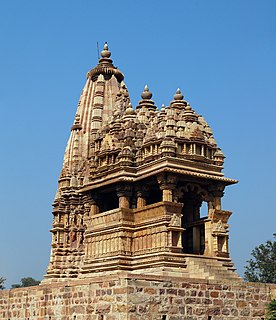
The Javari Temple in Khajuraho, India, is a Hindu temple, which forms part of the Khajuraho Group of Monuments, a UNESCO World Heritage Site. It was built between c. 975 and 1100 A.D.

The Lakshmana Temple is a 10th-century Hindu temple built by Yashovarman located in Khajuraho, India. It is dedicated to Vaikuntha Vishnu - an aspect of Vishnu.
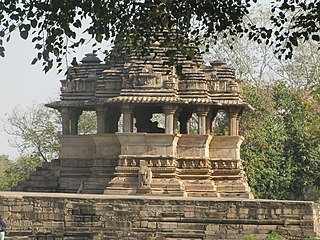
The Nandi temple is a Hindu temple in Khajuraho town of Madhya Pradesh, India. It is dedicated to Nandi, the bull which serves as the mount (vāhana) of Shiva, in Hindu mythology. As a common architecture trend, temples of Shiva display stone images of a seated Nandi facing Shiva. Following the trend, this temple is located opposite to the Vishvanatha Temple, which is dedicate to Shiva.

Parvati Temple is a temple dedicated to the goddess Parvati, consort of Shiva.

Vamana temple is a Hindu temple dedicated to Vamana, an avatar of the god Vishnu. The temple was built between assignable to circa 1050-75. It forms part of the Khajuraho Group of Monuments, a UNESCO World Heritage Site.

The Vishvanatha Temple is a Hindu temple in Madhya Pradesh, India. It is located among the western group of Khajuraho Monuments, a UNESCO World Heritage site. The temple is dedicated to Shiva, who is also known as "Vishvanatha", meaning "Lord of the Universe".

Parshvanatha temple is a 10th-century Jain temple at Khajuraho in Madhya Pradesh, India. It is now dedicated to Parshvanatha, although it was probably built as an Adinatha shrine during the Chandela period. Despite the temple's Jain affiliation, its exterior walls feature Vaishnavaite themes. The entrance has an inscription with a most-perfect magic square. It is part of a UNESCO World Heritage Site along with other temples in the Khajuraho Group of Monuments.

Adinatha temple is a Jain temple located at Khajuraho in Madhya Pradesh, India. It is dedicated to the Jain tirthankara Adinatha, although its exterior walls also feature Hindu deities. This temple is part of UNESCO World Heritage Site along with other temples in Khajuraho Group of Monuments.

Shantinatha temple is a Jain temple located among the Jain temple cluster in eastern Khajuraho in Madhya Pradesh, India. While its main deity is the Jain tirthankara Shantinatha, it includes 18 shrines with numerous Jain images.
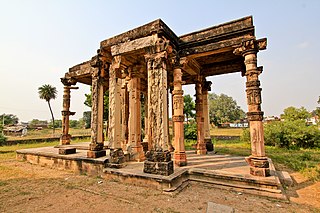
The Ghantai temple, also known as the Ghanti temple, is a ruined Jain temple in the Khajuraho town of Madhya Pradesh, India. Similar in style to the Parshvanatha temple, it was dedicated to the Jain tirthankara Rishabhanatha. This temple is part of UNESCO World Heritage Site along with other temples in Khajuraho Group of Monuments.
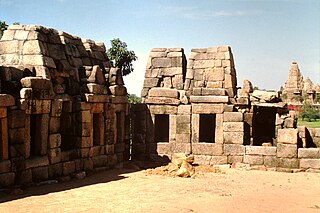
The Chausath Yogini temple is a ruined Yogini temple in the Khajuraho town of Madhya Pradesh, India. Dated to the late 9th century, it is the oldest surviving temple at Khajuraho. Unlike the Yogini temples at other places, it has a rectangular plan, but like them it is hypaethral, open to the air.

The Matangeshvara temple is a Shiva temple in the Khajuraho town of Madhya Pradesh, India. It is located among the Western group of temples. Among the Chandela-era monuments of Khajuraho, it is the only Hindu temple that is still actively used for worship.

The Chitragupta temple is an 11th-century temple of Surya in the Khajuraho town of Madhya Pradesh, India. Architecturally, it is very similar to the nearby Jagadambi temple.

Kakanmaṭh is a ruined 11th century Shiva temple located at Sihoniya in Madhya Pradesh, India. It was built by the Kachchhapaghata ruler Kirttiraja. Only a part of the original temple complex now survives. Some of the sculptures from the site are now located at Gwalior.

The Shiva temple is located at Bavka in Dahod district, Gujarat, India. It is located on a knoll near Hirlav lake between Bavka and Chandavada village, 14 km from Dahod.

Brahma Temple is a ninth or early tenth century temple and is located at Chhatarpur in Madhya Pradesh, India. Although titled after the Hindu god Brahma, the temple is dedicated to Shiva. This temple, along with many others form the UNESCO World Heritage Site of Khajuraho Group of Monuments.






















